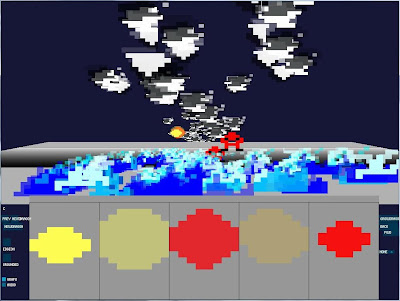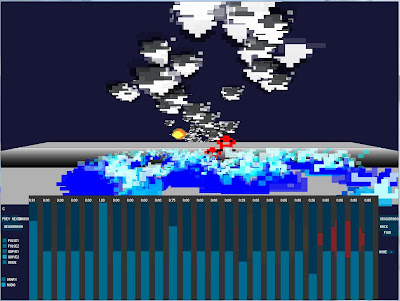Hi Everyone,
I'd like to share some details about a software project I've been working on- I hope it will turn into a fun and useful tool for electronic musicians and VJ's.
It is a hybrid sequencer for simultaneously creating (chip- style) music and (pixel- style) visuals. The concept is heavily influenced by old-school sprite-scaling video games. You can create sets of 2D pixel-art 'cards', then stack the cards into 3D shapes called 'dragons'. Each dragon represents a musical note, and contains a graph of time-varying music parameters (similar to the concept of an Instrument Definition in a tracker). By placing the dragons into a 3D world (in real-time or step-time), you can build up an entire tune.
As the final step, you will be able to interact with your composition by playing it like a video game-- jamming, changing notes, and applying effects to create a live performance.
Currently I am building a prototype in Processing.
Although it's in very early stages, it already seems fun and promising to play with.
Here is a screenshot, just a teaser really. It will probably seem cryptic since it's unfinished, but perhaps will give a feel for where things are going:
This will be available first as Windows/OS X compatible software; and eventually I intend to release it for iPhone/iPad/Android as well -- I think this type of software will be very well suited to tablet/touch input.
Some more details of the design:
-music engine to be similar to NES or gameboy audio capabilities (2 or more pulse channels with pwm, triangle, noise, 1 or more wavetable channels)
-graphics to be based on fairly low-rez sprites, probably 8x8 and/or 8x16
-sequencing engine based on a 60hz framerate for both audio and video
-I'm thinking about ideas for data interchange with Famitracker, LSDJ, etc.??
-midi input and gamepad input to be included
This thing is in early stages but I'm making a lot of progress on it these days, and I'm really excited to get some feedback. If the forum is interested in this type of thing, I will post further developments on this thread. At some point, I will also be looking for beta testers. I am very interested in collaboration, hacking, scripting, customizing etc., so I am trying to figure out the best model for release-- freeware, shareware, open source, or similar. (And I appreciate any suggestions regarding which approach is best.)
Until now, I haven't shared the idea with anyone but a couple of close friends/collaborators; so I'm dying to know- what do people think of this concept? Would you be interested in using this type of thing? Are there any 'must-have' features you think I should keep in mind?
All questions/comments are welcome.




